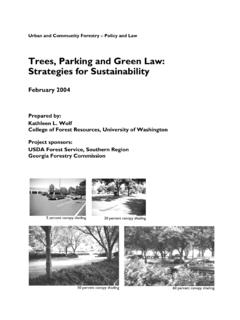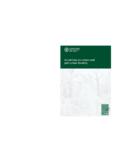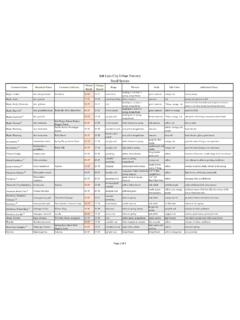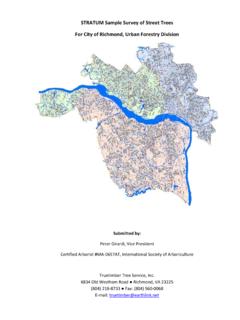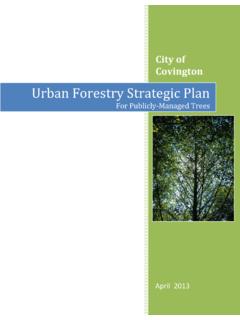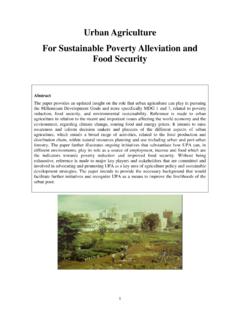Transcription of ROADSIDE URBAN TREES Balancing Safety and Community …
1 City streets are not just thoroughfares for motor vehicles. They oftendouble as public spaces where people walk, shop, meet, and generallyparticipate in many social and recreational activities that make urbanliving enjoyable. URBAN foresters, designers, and planners encouragestreetscape tree planting to enhance the livability of URBAN streets. Yet conventional transportation Safety guidelines regard treesand other fixed objects along a ROADSIDE as hazards and stronglydiscourage their use. A prevailing principle in ROADSIDE design is the clear zone, which is an expression of the idea of a forgiving road-side. Today s engineering practices encourage design of roadsidesthat allow a vehicle leaving any roadway to safely recover beforeencountering a potentially hazardous, fixed TREES play many roles in Community features such as street TREES and on-street parking may bufferpedestrians from hazardous oncoming traffic.
2 Landscape providesspatial definition to the public right-of-way. Extensive research hasdocumented environmental, social, and economic benefits for com-munities, municipalities, and regions. Directly related to transportation, studies have found that driversjudge forested URBAN highways to have higher visual quality. Peoplehave more favorable perceptions of communities with green roads,and visitors to forested central business districts claim they will spend9 to 12 percent more for products. Drivers seeing natural roadsideviews show lower levels of stress and frustration compared to thoseviewing built , this evidence is not yet widely acknowledged withinthe transportation industry. Tree crash statistics are often weighedagainst anecdotal reports of tree benefits in transportation decisionmaking. Discussions of ROADSIDE TREES are largely framed in terms ofaesthetic values, which are not viewed as justification for tree reten-tion or planting when weighed against long-held Safety standards.
3 Context Sensitive Solutions is a national policy intended tobetter incorporate local Community values into transportation plan-ning processes and products. Many communities seek to better inte-grate the needs of pedestrians and local developmental objectivesinto the design of their roadways. The starting point for bettercommunity-based ROADSIDE design is adequate KnowledgeCircumstances of tree crashes in URBAN settings are not now wellunderstood. Few accident studies have looked closely at urbansettings. Clear zones and other forgiving design practices have a lessthan clear relationship to Safety in URBAN environments and mayactually reduce Safety . There is a slowly growing body of evidencesuggesting that the inclusion of TREES and other streetscape featuresin the ROADSIDE environment may actually reduce crashes and injurieson URBAN roadways. Here is an overview of current team of scientists at the University of Washington analyzedarchived national accident data for the year 2002 to better under-stand the circumstances of tree crashes and to explore URBAN versusrural accident conditions (Wolf and Bratton 2006).
4 Our work wasfrustrated by the fact that little data about vegetation are collectedin standardized crash reports, though reports contain 91 failure to collect good information is unfortunate, because thenational database is analyzed extensively by the transportationindustry to inform national policy and upgrade design standards. While drivers do most of their driving in URBAN areas, manymore accidents occur in rural areas (63 percent) than URBAN areas(37 percent). Comparing speed for tree collisions and all crashes,we found that the average speed at which all accidents occurredwas 34 mph. The average speed at which drivers struck TREES wasROADSIDE URBAN TREESB alancing Safety and Community ValuesOne study found that natural ROADSIDE views produce lower levels of motorist stress and frustration compared to built settings. Another study founda decrease in crash rates on URBAN roads after landscape improvements were KRAMERBy Kathleen L.
5 NEWS DECEMBER 2006 48 mph, probably an outcome of the higher incidence of crashes inrural settings. We found an inverse relationship between drivingvolume and accident trends. About 62 percent of the miles traveledare in URBAN areas (totaling about trillion), but most of the crasheswith TREES (61 percent) occur in rural study in Florida compared a section of road that had landscapingand other livability improvements with nearly identical roads that did nothave Community improvements (Dumbaugh 2005). Conventional streetsafety guidelines maintain that increased numbers of objects in the road-side and constrained rights-of-way will increase accident rates. Actually,as the investigator reported, by any meaningful Safety benchmark total mid-block crashes, injuries, or fatalities there can be littledoubt that the livable section is the safer roadway.
6 Pedestrian andbicyclist injuries were likewise fewer in the improved road study compared accidents before and after placementof landscape improvements on five arterial roadways in downtownToronto, Ontario (Naderi 2003). The existence of features such astrees and planters in the URBAN ROADSIDE , based on pre- and post-tests, resulted in reduced numbers of mid-block crashes on all testroads. The numbers of crashes decreased between 5 and 20 percenton studied roads, though mid-block crashes generally increasedthroughout the city. Did TREES cause the reductions? The studycouldn t confirm that interpretation, but the investigator suggeststhat the presence of a well-defined road edge may cause drivers tobe more attentive and , a study of Texas URBAN roads found a decrease in crashrates on ten URBAN arterial and highway sites after landscape improve-ments were installed (Mok et al.)
7 2006). Accident records were usedto compare accident rates pre- and post-planting over three- to five-year time spans. The road sections were carefully screened from 61possible sites. The science team acknowledged the limitations ofthe after-the-fact study but suggest that landscape may be an inte-gral part of the Safety management of URBAN roads. They note that the landscape not only contributes to greater aesthetic compatibil-ity between the URBAN environment and the highway but maycontribute to a safer street. Future StudyThose who question prevailing ROADSIDE design standards do not intendto brush aside the consequences of tree crashes. There is indeed causefor concern. In 2003 alone, there were more than 8,500 fatalitiesinvolving ROADSIDE objects such as TREES and utility poles on , accounting for more than 20 percent of the total fatalitiesfor that year (according to the National Highway Traffic SafetyAdministration).
8 Nonetheless, it is important to put these numbers in the approximately 233 billion vehicle trips taken in the UnitedStates in 2002, TREES were involved in percent of all crashes. Intotal, the risk of an URBAN tree accident is about 1:100,000, or aboutthe same risk level as injury in an airplane accident. Should zero level of risk be a Community s goal, or should othertree benefits and functions be considered a trade-off for some degreeof Safety ? Such risk analysis is done for many other issues in oursociety, such as treatment of rare diseases or regulation of pharma-ceuticals. Risk assessment research could quantify the level of valuea Community places on TREES and more livable behavior is another issue. Few studies have explored howdrivers respond to ROADSIDE features. Elimination of a single roadsideelement, such as TREES , will not eliminate risk. Driver error is a factorthat contributes to more than 95 percent of traffic accidents.
9 Forinstance, the most common situation for an accident is a winding andrural road, with the vehicle leaving the road on the outside of curves. Personal choices have great influence over the vehicle leaving theroad, as well as the outcome of any crash that may occur. Drunkdriving accounts for as much as half of all traffic fatalities. In all coun-tries with high use of automobiles, male traffic fatalities outnumberfemale fatalities by about a factor of two. Many crashes occur onweekends and during late evening hours and often involve exces-sive speeds. Drivers traveling in excess of posted speeds account forabout 30 percent of all traffic fatalities. Meanwhile, seat belt usereduces a driver s risk of death in a crash by 42 science can contribute knowledge about TREES androadside environments in ways that improve forest health and humanhealth alike. There needs to be better collaboration between urbanforesters and the transportation officials to find better solutions fortree planting along city streets.
10 The transportation industry is generallyless aware of recent advances in ROADSIDE vegetation management,and engineers haven t yet acknowledged that there are professionaland scientific groups (such as ISA and the Society of MunicipalArborists) that could contribute to such studies. Transportation officials admit that research about URBAN roadsidedesign in the United States is limited in both scope and of these limitations, city street designers apply principleslearned in a rural highway environment to URBAN roads. Better urbanroadway data systems and Safety analysis should be created. Researchresources are needed to better understand where and under whatconditions URBAN forest and other streetscape improvements arehazardous, benign, or even helpful. Foresters and arborists can part-ner in research and design that result in safer and more livable , E. 2005. Safe streets, livable streets.
